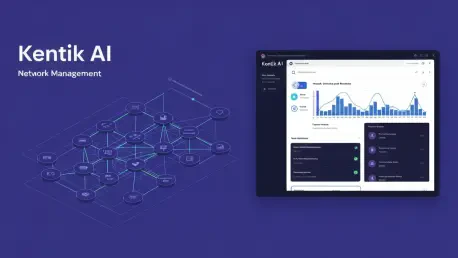Unveiling the Network Intelligence Revolution
In an era where digital infrastructure serves as the backbone of global business, managing sprawling and intricate networks presents a monumental challenge for enterprises and service providers alike, especially as complexity escalates due to cloud adoption and the surge in connected devices. The industry stands at a critical juncture, with a staggering market projection revealing that the global AI in networks sector is expected to soar from USD 15.28 billion in 2025 to USD 192.42 billion by 2034, signaling a transformative shift toward automation. This analysis delves into how Kentik AI Advisor, launched on November 18, 2025, emerges as a game-changer in this dynamic landscape, offering unparalleled intelligence to navigate operational hurdles. By examining market trends, product capabilities, and future outlooks, this exploration aims to illuminate the strategic importance of AI-driven solutions in reshaping network management.
Dissecting Market Trends in Network Management
The Surge of AI Adoption in Network Operations
The network management sector is undergoing a profound transformation, driven by the urgent need for automation amid growing infrastructure demands. Industry data underscores a pressing talent shortage, with a significant portion of seasoned U.S. network engineers nearing retirement, amplifying the strain on existing teams. This gap, coupled with the expansion of hybrid and cloud environments, has propelled AI solutions to the forefront as indispensable tools for maintaining efficiency. Companies are increasingly pivoting toward intelligent systems that can handle vast data volumes and deliver actionable insights, marking a departure from manual, reactive approaches to a more proactive stance.
Economic Pressures and Cost Optimization Needs
Economic factors are also steering the market, as organizations grapple with balancing high performance against tight budgets. The ability to optimize costs across on-premises and cloud setups has become a priority, especially with fluctuating expenses in Virtual Private Clouds, transit, and peering arrangements. AI technologies that can analyze network telemetry to pinpoint savings opportunities are gaining traction, reflecting a broader trend of fiscal prudence. This focus on cost efficiency is not merely a short-term fix but a strategic imperative for sustaining growth in a competitive digital economy.
Rising Complexity with Edge Computing and 5G
Another defining trend is the escalating complexity introduced by edge computing and 5G proliferation, which are reshaping network architectures at an unprecedented pace. These advancements, while enhancing connectivity and speed, create intricate challenges in capacity planning and security management. The market is witnessing a surge in demand for solutions that can forecast utilization trends and mitigate risks like Distributed Denial of Service (DDoS) attacks in real time. As these technologies continue to evolve, the reliance on AI to manage and secure expansive networks is expected to intensify, positioning the sector for robust expansion.
In-Depth Analysis of Kentik AI Advisor’s Market Impact
Driving Operational Efficiency through Innovation
Kentik AI Advisor stands out as a pioneering force in this evolving market, leveraging a proprietary Data Engine capable of processing a trillion telemetry points daily to unify disparate data sources. This capability enables the tool to offer deep insights into network operations, from identifying cost-saving measures to enhancing troubleshooting processes. By automating labor-intensive tasks, it addresses critical pain points such as limited resources and time constraints, allowing teams to focus on strategic initiatives rather than routine maintenance.
Transforming Security and Customization Standards
Security remains a cornerstone of network management, and Kentik AI Advisor excels by providing rapid incident response capabilities, particularly in distinguishing genuine DDoS threats from irrelevant noise. Beyond this, its integration of institutional knowledge through custom runbooks ensures recommendations are tailored to specific business contexts, a feature that resonates strongly in diverse regulatory environments. This blend of advanced AI reasoning and domain expertise sets a new benchmark, challenging the notion that automated tools lack the nuance of human judgment.
Forecasting Growth and Competitive Positioning
Looking ahead, Kentik AI Advisor is well-positioned to capitalize on the projected market growth from USD 15.28 billion in 2025 to USD 192.42 billion by 2034. Its agentic AI approach, which autonomously interprets user intent and executes plans, aligns with the industry’s shift toward autonomous operations. As competitors scramble to match these capabilities, Kentik’s emphasis on transparent decision-making and scalability offers a distinct edge. However, potential regulatory constraints around data privacy could influence deployment strategies, necessitating agile adaptations to maintain market leadership.
Reflecting on Strategic Implications and Future Pathways
The analysis of Kentik AI Advisor’s launch and its resonance with market trends paints a clear picture of a sector in rapid evolution, driven by automation and intelligence. It is evident that the challenges of talent shortages, cost pressures, and technological advancements have created fertile ground for AI solutions to thrive. The tool’s ability to revolutionize efficiency, security, and planning marks a pivotal moment for network management practices.
Moving forward, organizations are encouraged to adopt AI-driven tools as a core component of their infrastructure strategy, starting with high-impact areas like troubleshooting and cost optimization. Investing in training to blend human oversight with automated insights emerges as a critical step to maximize benefits. Additionally, staying attuned to regulatory developments around data handling proves essential to ensure compliance while scaling operations. As the market continues to expand, those who embrace such innovations early stand to gain a competitive advantage, building resilient networks poised for future demands.









